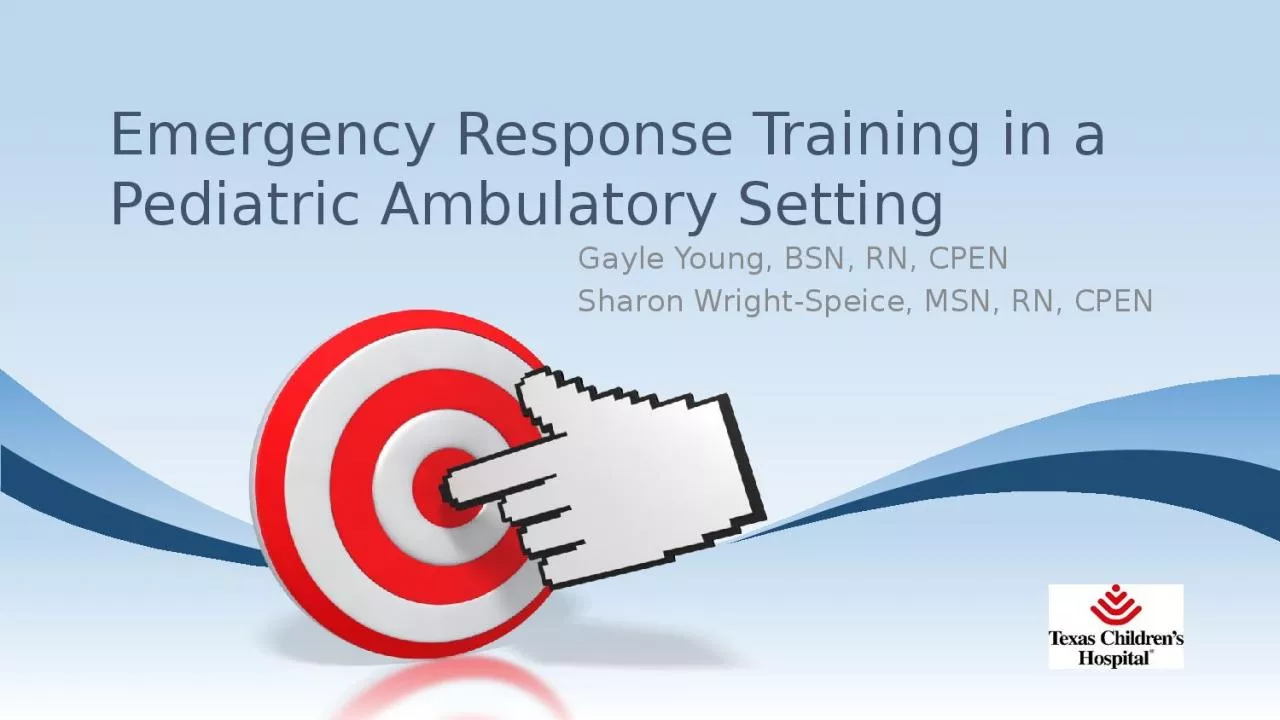

Gayle Young BSN RN CPEN Sharon WrightSpeice MSN RN CPEN Learner Outcomes for the Day Discuss development of emergency response training in a pediatric ambulatory setting Describe learnerspecific actions to enhance training ID: 1034629
Download Presentation The PPT/PDF document "Emergency Response Training in a Pediatr..." is the property of its rightful owner. Permission is granted to download and print the materials on this web site for personal, non-commercial use only, and to display it on your personal computer provided you do not modify the materials and that you retain all copyright notices contained in the materials. By downloading content from our website, you accept the terms of this agreement.
1. Emergency Response Training in a Pediatric Ambulatory SettingGayle Young, BSN, RN, CPENSharon Wright-Speice, MSN, RN, CPEN
2. Learner Outcomes for the DayDiscuss development of emergency response training in a pediatric ambulatory settingDescribe learner-specific actions to enhance trainingEvaluate effectiveness of training
3. History and DevelopmentIdentify ambulatory groups over three hospital campuses
4. Historical emergency response training for ambulatory staffBasic Life Support (BLS) requirementMock codes in clinics and centersEducational assessments identified a need for formal and comprehensive pediatric emergency trainingHistory and development
5. Pediatric Emergency Assessment, Recognition, and Stabilization (PEARS)- best optionAHA Educational GuidelinesConsistent, contextual, hands-on practice, debriefing, and evaluationGoal - 440 staff PEARS-certified by October 2018Monthly classes to start October 2016Led by Nursing Professional Development (NPD)History and development
6. Identify Key StakeholdersAmbulatory EducatorsDevelopment - to become PEARS InstructorsAmbulatory Participants- Nurses and Medical Assistants (MAs)History and development
7. P : Pediatric E : Emergency A : AssessmentR : RecognitionS : StabilizationWhat is PEARS?
8. PEARS® is an American Heart Association (AHA) course that helps develop healthcare providers knowledge and skills essential for emergency evaluation and initial stabilization of the seriously ill infant or child.Program Description
9. Pediatric assessmentAssessment and management of respiratory problemsRecognition and management of shockIdentification and management of cardiac arrestPractice resuscitation team conceptPEARS Learner Outcomes
10. PEARS Group Dynamics History
11. Developed Pediatric Identification of Emergency and Response (PIER) to meet the need of the emerged target groupPIER is for unlicensed healthcare personnel PIER content is based off the PEARS for consistencyNew Program Development
12. P : Pediatric I : IdentificationE : Emergency R : ResponseWhat is PIER?
13. Difference in PEARS vs PIER?PEARSPIER ASSESSMENT:Nurses will identify, assess, and manage a deteriorating patientIDENTIFY:MAs will identify a deteriorating patient and notify a nurse and/or provider Nurses receive anAmerican Heart Association (AHA) Certification Card MAs receive a Certificate of completion
14. PEARSAssessment and management of respiratory problemsAssessment and management of shockAssessment and management of cardiac arrestPractice resuscitation team conceptPIERRecognize a seriously ill or injured child by abnormalRespiratory signs and symptomsSkin colorVital signsPerform basic life support (BLS) Effective team interaction within scopeDifference in Learner Outcomes?
15. PEARSCode cartUtilize code cart supplies, medications, and equipmentDefibrillator/AEDOperate AEDPIERCode cartIdentify and retrieve key code cart supplies and equipmentDefibrillator/AEDOperate AED Difference in Skills Stations?
16. Confidence SurveyMeasure change (+/-) in the level of the participants confidence and perceptionPost-Class EvaluationMeasure if the program met the learning outcomesHow Effective was the Training?
17. PEARS Pre & Post Survey Datan=41
18. Question / IndicatorPrePost1. I understand my responsibilities in an emergency situation with an ill or inured child3.33.82. I understand how and when to get help in an emergency situation for an ill or injured child3.43.83. I am confident in my ability to recognize abnormal respiratory signs3.43.84. I am confident in my ability to recognize abnormal skin color and vital signs.3.43.85. I can identify equipment needed in an emergency situation for an ill or injured child.3.13.86. I know how to initiate the steps of basic life support (BLS) for an infant or child. 3.43.8PIER Pre & Post Survey Datan=43
19. PEARS Evaluation SummaryScores Range: 4.94 – 4.99/5.0 Comments Include:Strength- open discussions, team problem solving.I really liked the action part of putting it all together- actually moving and getting supplies from the cart, etc.Classroom great for asking questions and getting feedback.Good pace. Enjoyed class size.The discussion/videos format is more effective to me than just listening to someone speak. The case studies were very helpful. Scenarios were helpful.
20. PIER Evaluation SummaryScores Range: 4.9 – 5.0/5.0 Comments Include:It was great to be familiar with the crash cart in case of emergencies.Class was much more informative for an MA vs. PEARS.Very informative, very interactive, great for hands-on learners!Loved it- makes my role in clinic/emergency situation have more clarity!More focus on our role of assisting and not leading in an emergent situation due to lack of experience compared with our nursing team members.
21. Questions?More Information?
22. ReferencesAmerican Heart Association. (2017). About CPR & First Aid. Retrieved from http://cpr.heart.org/AHAECC/CPRAndECC/AboutCPRFirstAid/CPRFactsAnd Stats/UCM_475731_Out-of-hospital-Chain-of-Survival.jspAmerican Heart Association. (2012). Pediatric emergency assessment, recognition, and stabilization. : First American Heart Association.